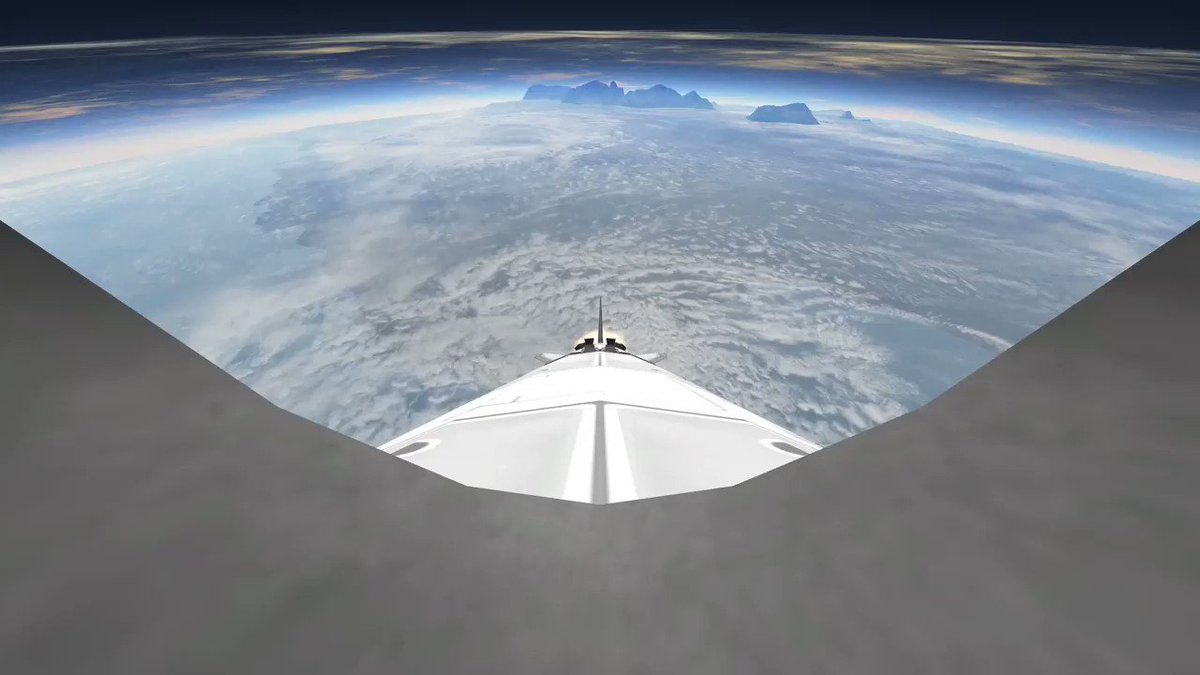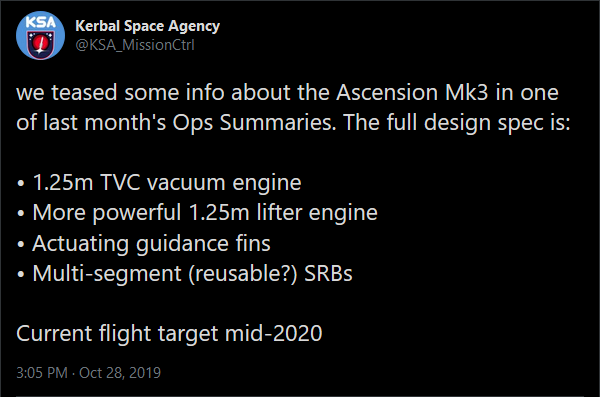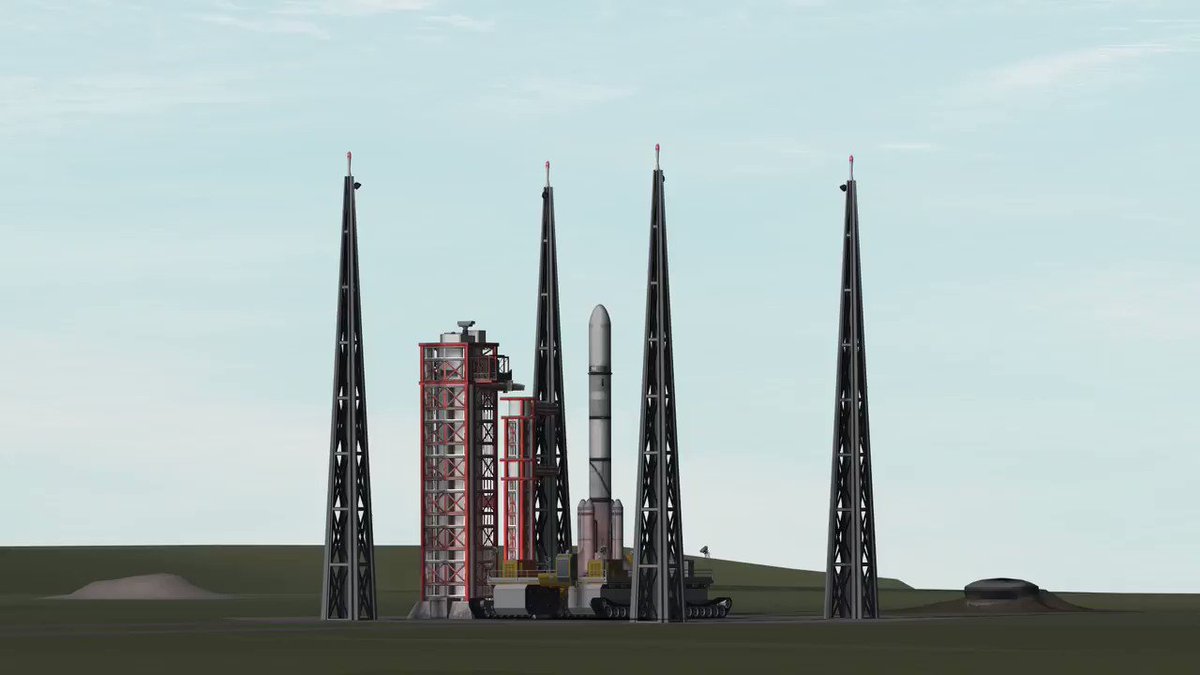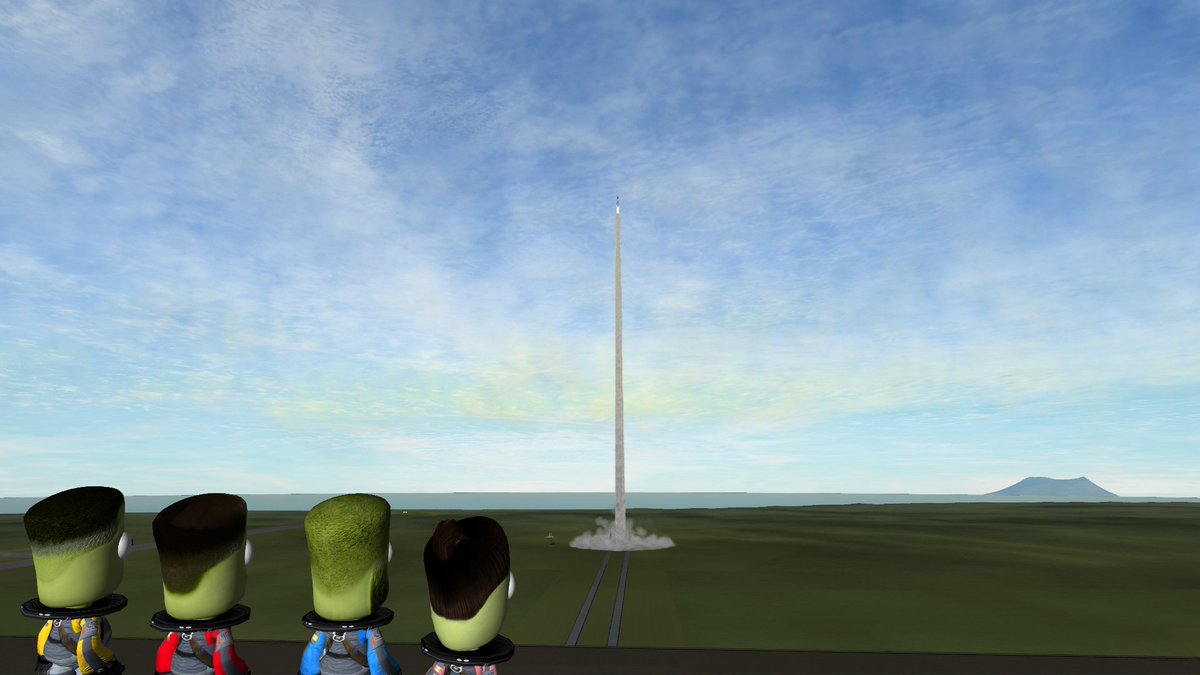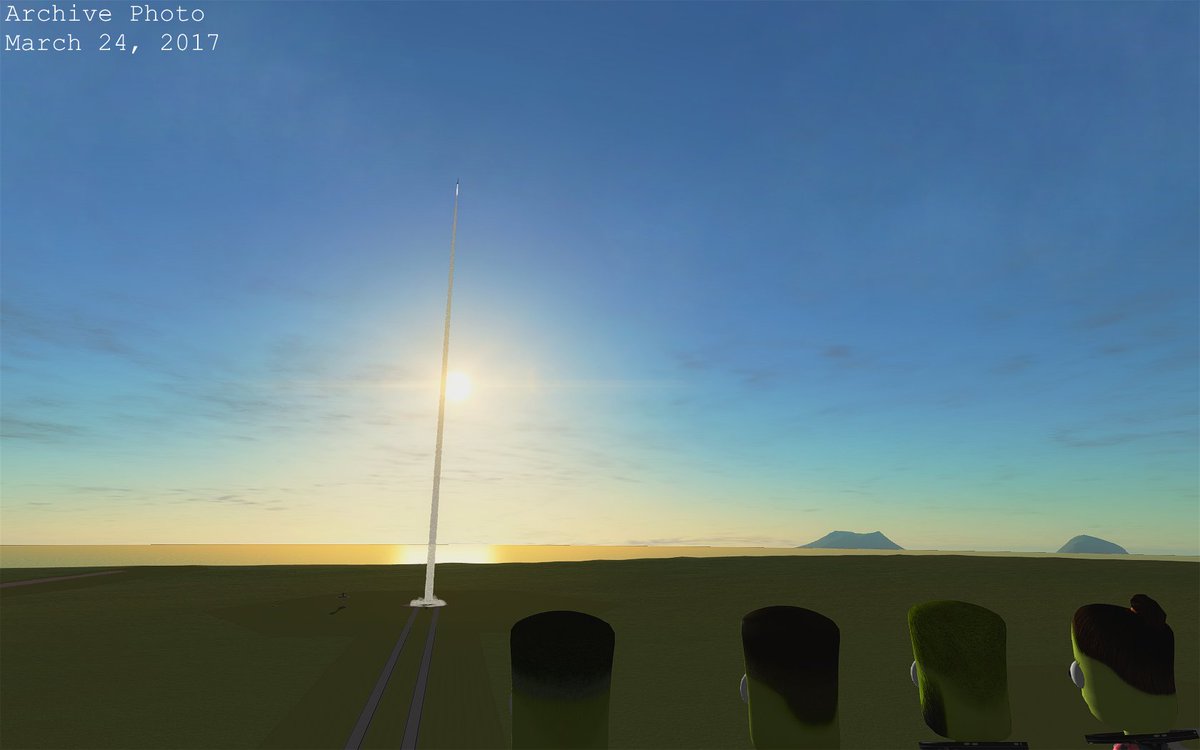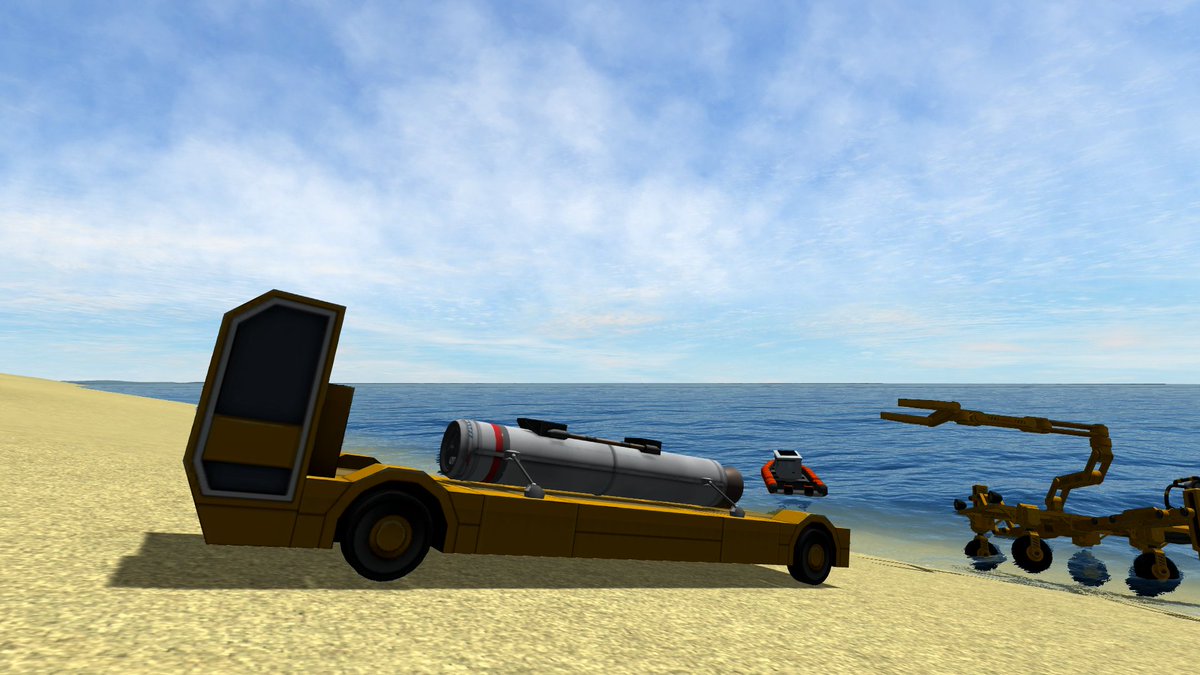|
Progeny Mk6 Block I Nails Debut Flight, Fails Recovery
Yesterday saw the first successful flight of the Progeny Mk6 Block I, but this wasn’t much of a surprise given the Mk6 has technically launched 3 times before already when it was still designated as the Mk5. The fin-less 3rd stage is mainly what changed the visual profile enough to warrant a move to the Mk6 designation. Regardless, everyone was pleased with the flight especially since a new factor was present – launching 15° south. It’s easy to fly a ballistic rocket in the same direction that the planet is spinning, but once you start shooting off-axis you can expect the planet’s rotation to have an effect on the flight. 15° did not cause any significant issues and further review of telemetry data is ongoing to spot any effects that could become serious as we continue to increase launch azimuth to further probe the radiation field above the planet.
Unfortunately despite the success of the flight we appear to have lost the rocket on splashdown. Traveling a record 258km downrange by the time signal was lost over the horizon, MSV Tongjess arrived in the area over 5 hours later and could not detect any locator beacon from the payload (the independent power source for the beacon lasts 10 hours). The rocket was traveling at 2.178km/s when signal was lost and speed was still increasing. Despite our efforts in deploying the chute later and detaching the fairings to induce more drag it seems the speed was just too much. The unfortunate thing about a water landing is that it leaves no trace of impact, so we can’t deduce how fast the payload was traveling when it struck the water. Who knows, maybe we came close to landing intact.
As we said, further data analysis is ongoing and a full report is expected early next week.
Deuce Science Mission Encounters Radiation Hazard at Northern Polar Region
Another big mission this past week was the Deuce flight up to the Northern Ice Shelf, a region of Kerbin that has not been explored in nearly half a millennium. Yes, some trips have been made to the North and South poles for the sake of fame but interest in the regions never amounted to much scientifically – they were just frozen wastelands. The Deuce carried a large suit of science instruments in its expansive cabin and Captain Jebediah and Commander Valentina were also tasked with visual observation of the area in addition to gathering data with the instruments. They failed to make it all the way to their objective as the radiation detector started picking up increasing levels of radiation when they flew north over the Tundra and Ice Caps. Originally at more than 6km Jeb turned around and dropped lower to see if levels would increase or decrease. The pair made a few trips into the radiation zone at various altitudes to record data the scientists back at KSC could analyze. Jeb and Val received nowhere near dangerous dosages but since this was an unknown factor in the mission they made the decision to terminate and head for their destination at Sheltered Rock.
Analysis of the radiation data showed that the lower the Deuce was the less radiation it received, which clearly indicates that the atmosphere is blanketing it out as it falls from space. How or if this ties into the radiation we’ve detected in our rocket flights over the equator has yet to be determined. We don’t plan to change our launches to northwards to see if we can connect the two regions. It could be that this is just radiation that sits over the poles only, and maybe even just the north pole.
The discovery of a radiation region also provides a potential opportunity for future studies and testing involving radiation to be carried out on the surface rather than in space, which is exciting for scientists. We mentioned that previous explorers have traversed the area in a time before radiation was known (you can read more about its discovery here) and none were known to have died from any kind of radiation sickness, so either the radiation doesn’t get too strong within the region or it doesn’t cover the entire pole. Lead Scientist Cheranne plans to work with Genesis team scientists to plan another polar mission but before then equipping the Deuce with some radiation shielding to allow Jeb and Val to safely push deeper into the region to find out.
KerBalloon Heads Far West
The Deuce wasn’t the only mission to go far this past week. Specialists Bill and Bob boarded Maritime Service Vessel Lymun on Monday to sail ~575km west and release a high-altitude balloon over the sea that lies between the two horns of the Great Desert. The launch was near the coast to get temperature readings as the balloon passed over land. They then deployed in two Utility Task Vehicles to track it down and recover it. While the launch went off without any delays, recovering the balloon took more effort than planned when the UTVs kept getting stuck in the sand. Eventually they had to give up, take supplies with them and trek on foot to the balloon and drag it back over 30km, which took over a day. Not a day cycle, an entire day. By the time they returned to port in Umbarg it was too late for MSV Lymun to resupply and head back out to recover the Progeny rocket launching shortly.
Ascension Readying for Engine Testing
The fuel tank, same as the one that will be flown on the actual rocket, arrived this week for the VAB to inspect and prepare for the K2-X engine to be mounted to it next week. The test stand is nearing completion out on the R&D campus lawn and will hold the entire tank and engine vertically. Initial rounds of testing will have short firings at various thrust levels going from low to high before a series of full-length burns are conducted. The testing will last around 2 weeks after which further analysis will be performed to decide whether the engine has met our requirements and can be rebuilt to perform the first Ascension flight by late April/early May.
ATN Database
The weekly update for the Asteroid Tracking Network database is available here, containing 1,562 asteroids and 4 updated with new observation data.
Celestial Snapshot of the Week
This image taken from the cockpit of the Deuce by Val shows that she didn’t tilt the camera sideways, this is just how celestial objects look when you are gazing at them along the same plane. Here at higher latitudes, you are standing more upright atop the sphere that is Kerbin, and so looking out into space everything else is horizontally aligned as well. Down at the equator where KSC is, you’re on the side of a sphere, so looking out you see things stacked vertically. We’re sure the flat Kerbin truthers have a different explanation of course that somehow makes sense to them.
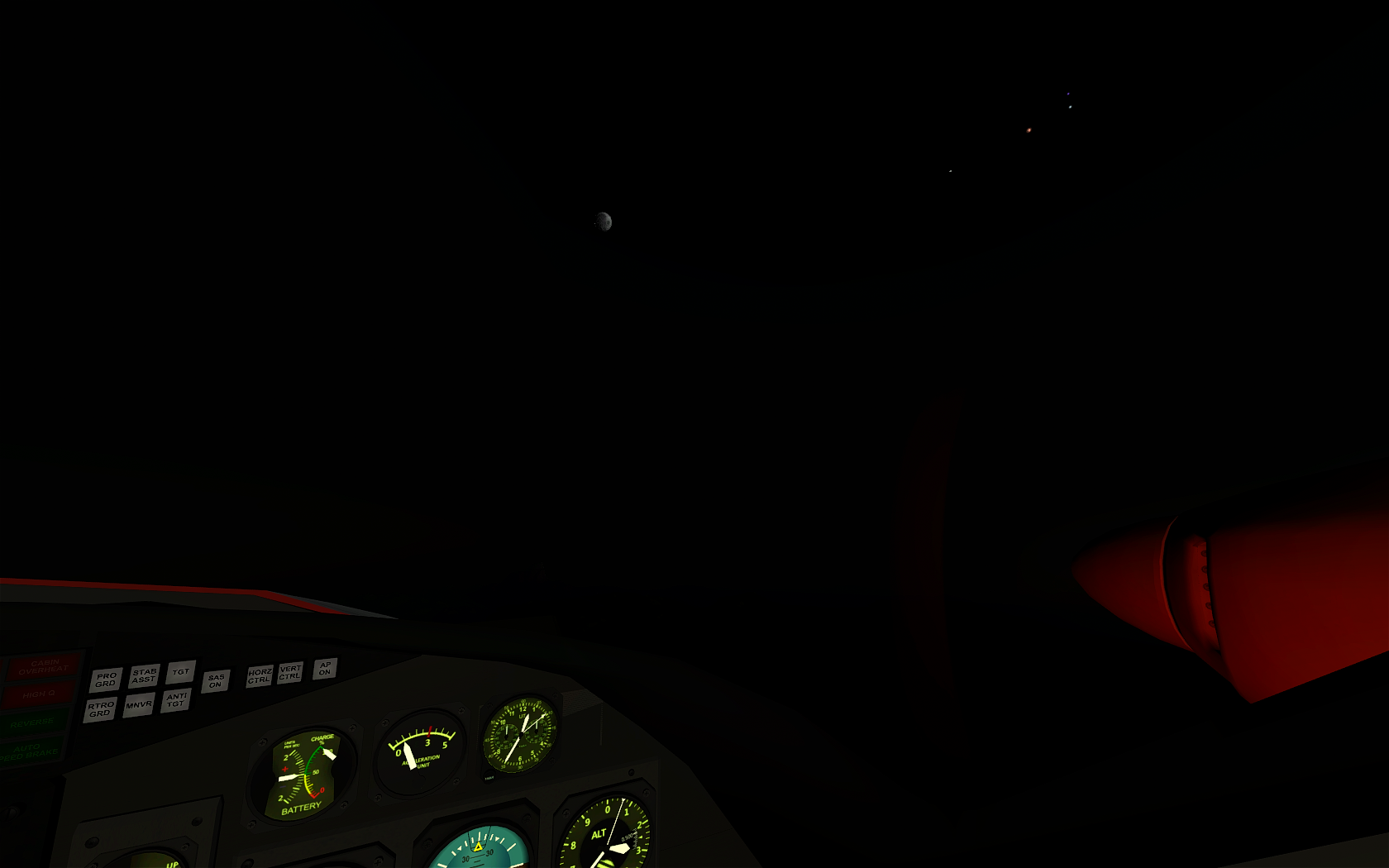 From the Desk of Drew Kerman
From the Desk of Drew Kerman
Out of Character Behind the Scenes stuffWritten on 2/14/17
Writing this in my text editor cause the website is still down. Something server-side got screwed because I didn’t touch any code or settings and suddenly all my WordPress sites began to have some sort of infinite redirect loop. A chat with support caused my issue to get escalated to a higher technician and eventually instead of redirecting infinitely the sites just said they couldn’t connect to the database. And then my host resolved my support case ambiguously, so I re-opened it asking WTF and that’s where we are now. I will have another support chat later today if it’s not fixed by then.
Olympics!
So yea it’s Wednesday, which actually isn’t so bad considering the huuuuge Deuce mission I had to fly and also a rocket launch and wow 22 images generated this week that is a whopper. The main hold back though has been keeping up with the Winter Games, which I completely forgot to factor in when I was writing about my progress last week. I’m all about the alpine events, mainly downhill since that’s pretty much how I ski on the slopes. Sliding events I mainly stick to bobsleigh but like watching highlights of skeleton and luge. Speed skating is another favorite of mine, mainly short track but time allowing I catch long track too. Halfpipe, snow cross – good stuff and now they have mass start speed skating! Hands down favorite though is Aerials, because I love trampoline and can do multiple twists and flips on it and love seeing the skiers go up doing that stuff. Crazy! So yea, these next two weeks won’t see much progress is building out a lead time 😛
Mk6 launch
Whoo hoo, finally nailed a launch on my first try! No repeats! Such satisfaction. Despite being the exact same rocket as the Mk5 that went up last there was some significant variation in the first and second stages of the flight I attribute to the southward launch that I look forward to exploring more in the data analysis and subsequent flights pointed further south.
I also figured out why Graphotron was messing up and not recording the start of the launches – I no longer use the STAGE command in kOS to kick off the launch, I actually ignite the booster and release the clamp programmatically and Graphotron needs a staging event to kick off its run. So now I modify the launch code a bit at launch to use the STAGE command but on Github you’ll still see the code doing it “properly”. Also looks like Graphotron uses Electric Charge while it is graphing, which is not a thing it advertises and something I never knew about until now. I made a post on the forum thread about it so the author makes this aspect more prominent on the tin and maybe include an option to disable it. I know I was already factoring in the use of the high data rate logging into the EC draw I set the probe core to.
Weird thing I noticed in the VAB was moving the lower stage fins around on the rocket would alter the length/width values shown in the engineer report. This is an issue because I use these numbers to calculate deploy costs. Now that I know it exists, I can keep an eye on it to make sure they are consistent, but not sure what’s going on there. Sticking the larger fin directly underneath the smaller upper fins seems to hide them from the dimensions calculator or something. I dunno didn’t mess with it much, just FYI to anyone else.
Lastly I’m starting to only keep video of the rocket ascending to space and descending through the atmosphere, lowering the video size from over 1GB down to around 100MB. Because my ascent script saves the game as soon as I enter space, I can always go back to check on anything that happened from that point on to re-entry. Still, I don’t trust the game to entirely set things up the same way, which is why I still record the re-entry.
Deuce mission
Yup, long flight – longest by far. Thankfully by the end of it the game was still running well with around a 60% time fraction meaning time was running 40% slower which did drag things out a bit in real time but not that much. The polar radiation was a real surprise, because I haven’t paid much attention to Kerbalism‘s radiation simulation. I’ve seen the fields made visible around Kerbin a few times before, but forgot about how they are laid out and that they affect the poles. But hey this works out great and the timing couldn’t have been better since Progeny is also probing out radiation regions. So yea again not a planned thing I just wanted to get to the polar region because I finally had a way to get there.









